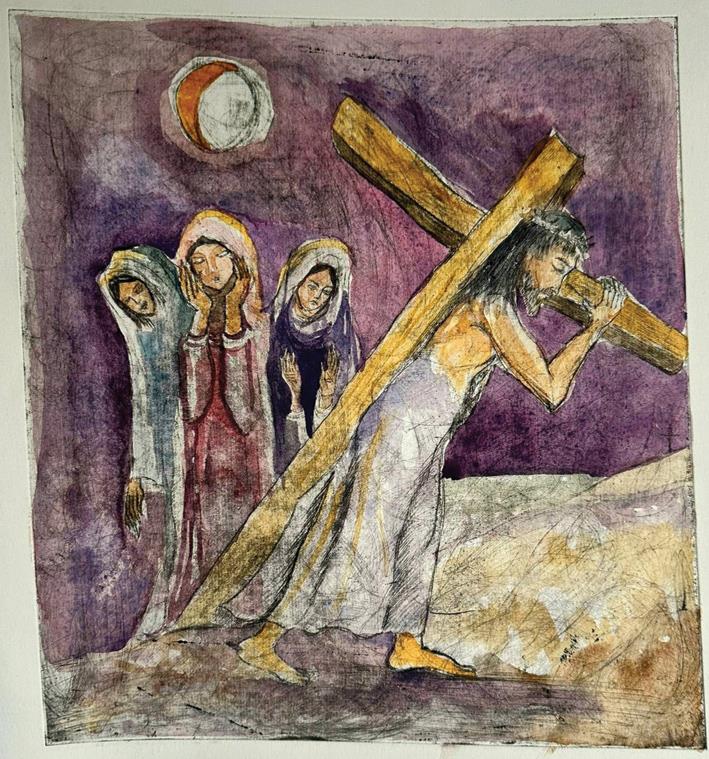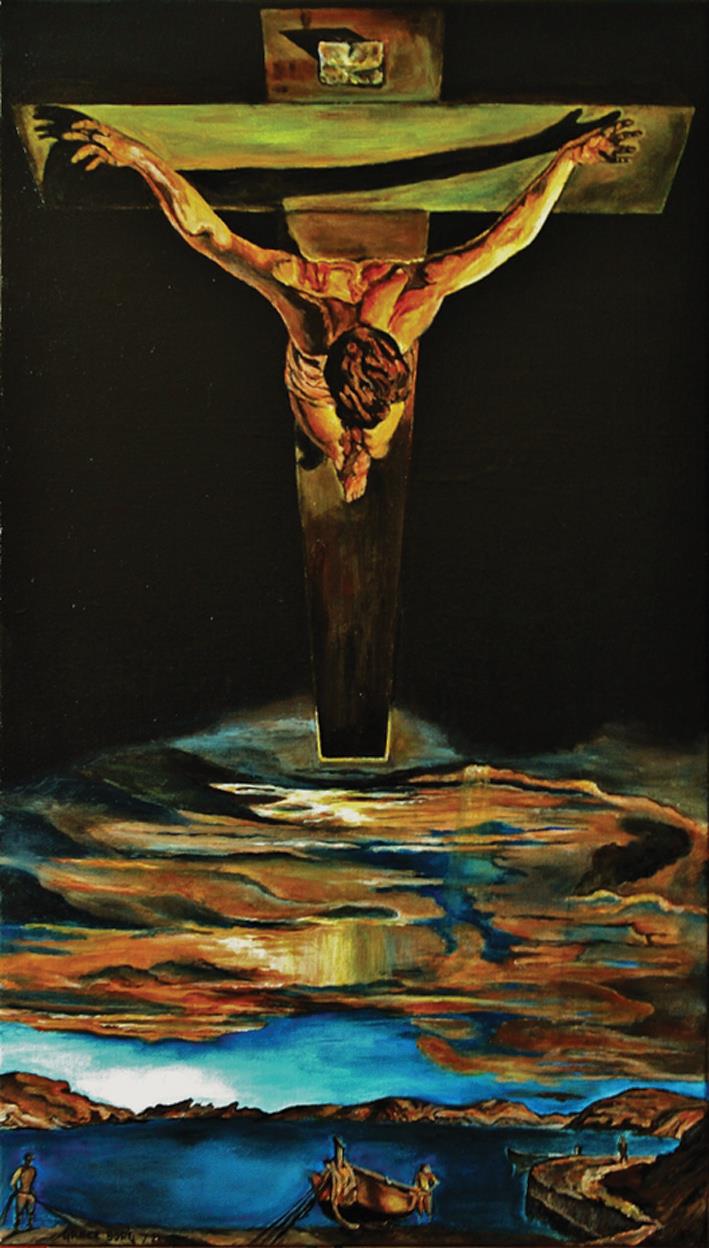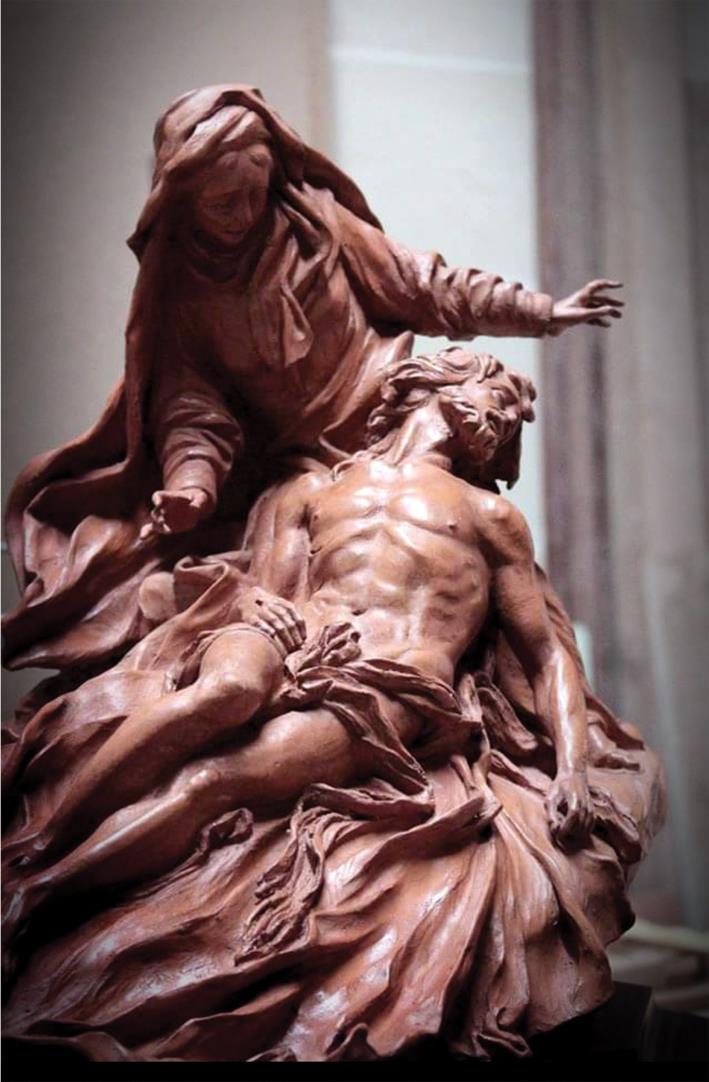ANTOINE CAMILLERI sent a handful of his works to choose from. Here are four of them.


GRACIE BORG
CHRIST OF SAINT JOHN OF THE CROSS
Over the years, I have painted several reproductions of the great masters. CHRIST OF SAINT JOHN OF THE CROSS, painted by Salvador Dalì in 1951, is one of the reproductions I so enjoyed painting. When I first saw the original of this painting in Kelvingrove Art Gallery in Glasgow, Scotland, I was really in awe of its majestic beauty. I made it a point to paint it. For me it is one of the most impressive paintings of the crucified Christ I have ever seen. My reproduction is now in a private collection.

Stephen Spiteri, the distinguished Maltese military historian sent me an email saying: "There is a really large and beautiful crucifix hanging from the dome at San Duminku, Rabat," and sent me the photo you see here. This after I remarked how much I had admired the beautiful, huge crucifixes decorating the streets of Naxxar."
The Church of St Dominic and the Blessed Virgin in Rabat is a fascinating site, steeped in history and spirituality. The church itself is renowned for its architectural beauty and religious significance. It serves as the motherhouse for the Dominican Order in Malta and is built upon the legend of an apparition of Our Lady around the year 1400.
The church also houses a miraculous statue of the Blessed Virgin, which has attracted pilgrims from around the world.
CROSS
As though nailed to your cross
the whole world's dying,
mothers at its feet
tending its wounds
praying
I have a memory of resurrection
and I pray too.
Mgg (Maria Grech Ganado)

CHRIS EBEJER
This dramatic terracotta sculpture, a Pietà by CHRIS EBEJER is a contemporary interpretation of a deeply rooted Christian theme.
In this composition, the Virgin Mary is captured in a moment of tender desolation as she cradles the lifeless body of Christ. The emotional tension is palpable; the sweeping folds of drapery, and the delicate interplay of gaze and posture. Mary's expression, partly shrouded by her veil, conveys both sorrow and reverence, that invites contemplation. Her arm outstretched in acceptance - is the very embodiment of grief that has passed throughout the last moments of her son's passion. Her eyes, shaded by the folds of her veil, look not only upon Christ but beyond him, as if seeing the void left in the world by his absence. The figure of Christ, rendered with anatomical detail and sublime restraint, lies gracefully across her lap. His body, though relaxed in death, speaks of past suffering, in complete surrender, though lifeless emanates a quiet nobility with a reverence that preserves dignity even in death.
The flowing drapery, carved with lyrical movement, feels almost like time melting away. It carries your gaze gently from the despair of the Virgin to the serenity on the face of her son. In that sacred transition, the viewer is caught - between heartbreak and peace, between the earthly and the divine.
Emotionally, the sculpture evokes a desperate feeling of holding someone you love for the last time, Yet within that sorrow is also grace - the kind that does not shout, but hums quietly through the chest. It reminds you of the kind of love that stays long after breath is gone. It is a meditation on love, loss, and the human condition - imbued with theological resonance and sculptural representation.

MARK SCHEMBRI
"Whose limp body is being carried by Christ? It is yours dear reader. You had to be carried because this harsh world wounded you and made you sick and then you wounded others and spread sickness in a neverending cycle. Whereupon, a God who is not indifferent allowed this same brutal world to crush Him so that he could carry you, sickness, wounds and all. The sickly yellow colour in this painting, the suffering in the eyes of the Redeemer illustrate this ineffable reality. A God who seems to have failed because nothing has changed, or has it?"

RICHARD ENGLAND
Two poems from Sanctuaries: Selected poems, published by Midsea books.
OF THESE HE DID NOT SPEAK
After announcing to the Virgin
the Immaculate Conception
and
the bloodless birth
the Angel wept
for although he knew too well
about
the
passion
and
the
death
of these he did not speak.
*******
I AM THE RESURRECTION
Betrayed by a kiss in a garden
nailed to a cross on a hill
laid to rest in a tomb
murdered by mankind.
There is a silence on the earth
there is a stillness in the air
the world is mute with grief.
For three days He slept in paradise
before rising from the dead
proclaiming
"I am the resurrection
he who believes in Me shall be redeemed."

STEPHEN SPITERI
What Holy Week means to me:
Holy Week represents the very essence of my Christian faith. It's a sacred time of spiritual reawakening, a celebration of Jesus' sacrifice and God's love for humanity. It is a time when, like St. Paul, 'we proclaim Christ crucified' to the world. For the crucifixion and the cross are at the centre of our faith and spirituality - an acceptance of suffering for our redemption. "Whoever does not take up his cross and follow me, is not worthy of me" (Matthew 10:38).
To me, Holy Week is a time of spiritual reflection, where the cross, and what it truly signifies, comes more sharply into focus. For in the cruelty of the crucifixion we come face to face not only with the passion of Jesus Christ and his great suffering - the product of man's dysfunction - but also with God's love and mercy, for having given us his beloved son to conquer our sins and secure our redemption and victory over death.
Stephen comments on his drawing:
"My pen drawing of Christ crucified finds its inspiration in the fallen, tortured trees one often sees in old photographs of the battlefields of the First World War - hellish scenes of ravaged landscapes punctuated by denuded trunks, bomb craters and barbed wire.
Nothing speaks more to me of desolation and desperation than the sight of torn and shattered trunks, felled or stripped of branches and reduced to skeletons strewn across a land devasted by gunfire and artillery bombardment.
Here in my drawings, the three central tree trunks represent the crosses on the Golgotha, laid out in a desolate, ravaged landscape - itself an allusion to man's loneliness and desperation in a godless world, redeemed only by Christ's sacrifice.
The sinuous, hanging figure of Christ pinned to the trunk of the central tree is inspired by, and seeks to emulate, Hendrick ter Brugghen's representation of the crucified Christ in his painting of the Crucifixion with the Virgin and St John (c.1625).